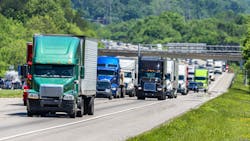Motor carriers and professional truck drivers are essential to our lives. As a law enforcement officer, I saw the hardworking folks in trucking as a partner in highway safety and often in emergency response. Still, there were those times when my colleagues and I were left wondering, “How did that carrier ever get on the road?”
Long before trucking companies face ongoing compliance with federal safety regulations, they must first qualify as interstate motor carriers. The steps necessary to begin life as a motor carrier ensure that every interstate transportation company understands the federal rules of the road, can be monitored for compliance, and meet various legal obligations.
These steps are in addition to state-level requirements for vehicle registration and state fuel taxes, both of which are managed through multistate compacts—the International Registration Plan and the International Fuel Tax Agreement—and similarly subject to roadside enforcement.
See also: Bad brakes, false logs were most common 2022 Roadcheck violations
So, how did that company ever get on the road? By taking the following steps:
The company went to the Federal Motor Carrier Safety Administration’s (FMCSA) website to get started in interstate transportation. Using the desired type of business operation—motor carrier, broker, intermodal equipment provider, cargo tank facility, shipper, or freight forwarder—the company followed the indicated next step.
For companies intending to transport passengers or haul cargo in interstate commerce (and meeting specified bus or truck sizes), the next step was obtaining a USDOT Number. Notably, many individual states listed on the FMCSA website require all their intrastate commercial motor vehicle registrants to obtain a U.S. Department of Transportation number. Also, all commercial intrastate hazardous materials carriers who haul hazmat types and quantities requiring a safety permit must register for a USDOT number. Hazmat carriers, interstate or intrastate, must separately obtain that hazardous materials safety permit.
Done? Not quite. If the company intends to become a for-hire motor carrier—that is, transporting passengers or federally-regulated commodities owned by others or arranging for their transport for a fee or other compensation in interstate commerce—then the company had to obtain FMCSA operating authority and register under the Unified Registration System.
For trucking companies, that operating authority is commonly known as the “MC Number,” although other types of operating authorities exist. The type of operating authority dictates the level of insurance/financial responsibilities a company must maintain and the legal documents which must be on file at FMCSA. There are fees associated with obtaining an FMCSA operating authority, and the process can take time. Private carriers (those hauling their own goods), carriers hauling exempt commodities, and those operating exclusively within a federally designated "commercial zone", do not need operating authority. As mentioned, there may be state-level requirements as well. The company contacted its state department of transportation, public utility commission, and/or the department of motor vehicles to determine those state-level requirements.The company received its temporary FMCSA operating authority and was ready to do business. In FMCSA eyes, though, the carrier was a “New Entrant.” This places the company under 18 months of enhanced safety scrutiny, including a safety audit and review in the first 12 months, with specified violations dictating automatic failure, before it receives permanent operating authority.
All companies with a USDOT Number or an FMCSA operating authority must file certain company information before beginning operations and every 24 months thereafter, as well as updating changes in a timely manner.
That’s how that carrier ever got on the road.
Steve Vaughn is vice president of field operations at PrePass Safety Alliance, the provider of PrePass weigh station bypass and toll-payment and management services. Vaughn served nearly three decades with the California Highway Patrol and is a past president of the Commercial Vehicle Safety Alliance.
About the Author
Steve Vaughn
Senior Vice President of Field Operations
Steve Vaughn is senior vice president of field operations at PrePass Safety Alliance, the provider of PrePass weigh station bypass and electronic toll-payment and management services. Vaughn served nearly three decades with the California Highway Patrol and is a past president of the Commercial Vehicle Safety Alliance.
